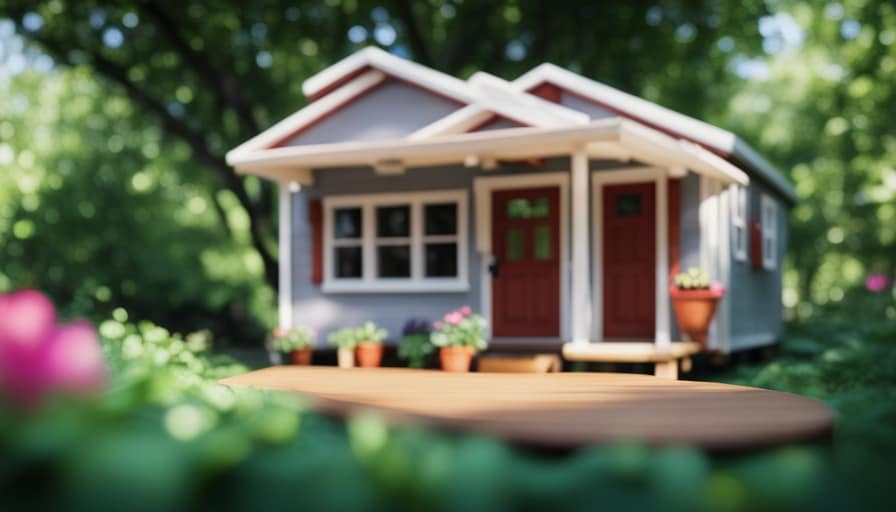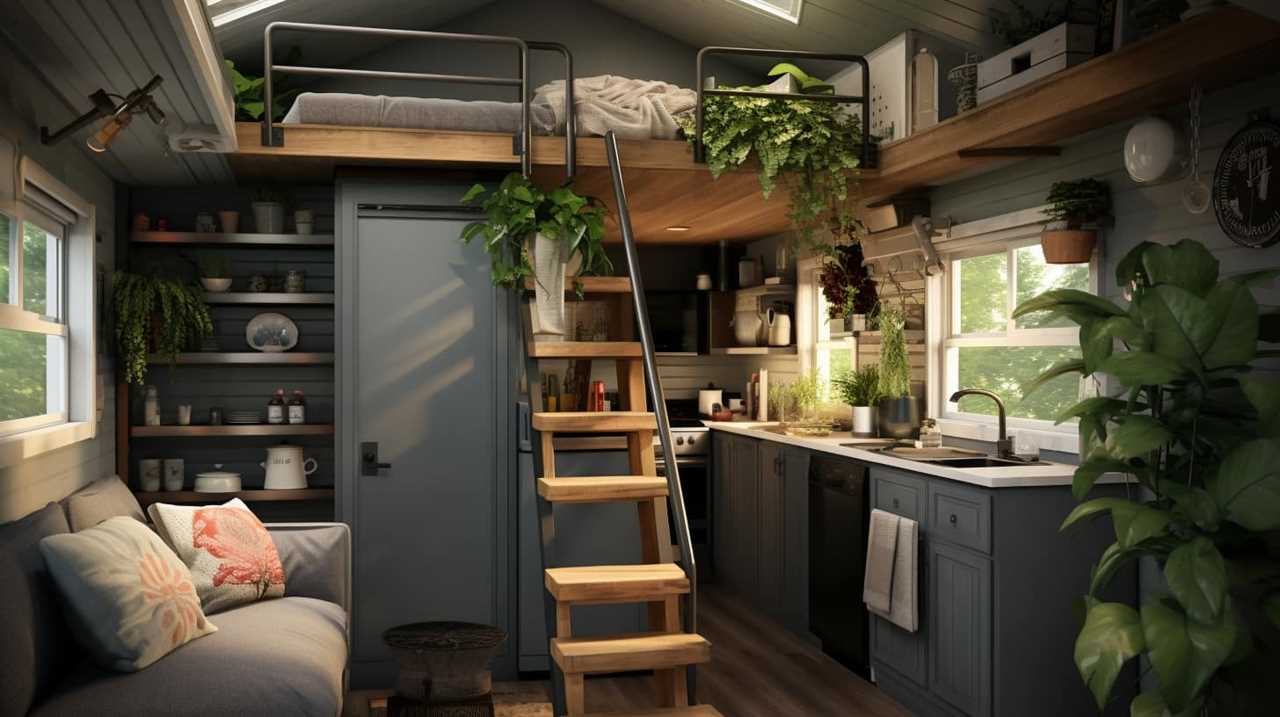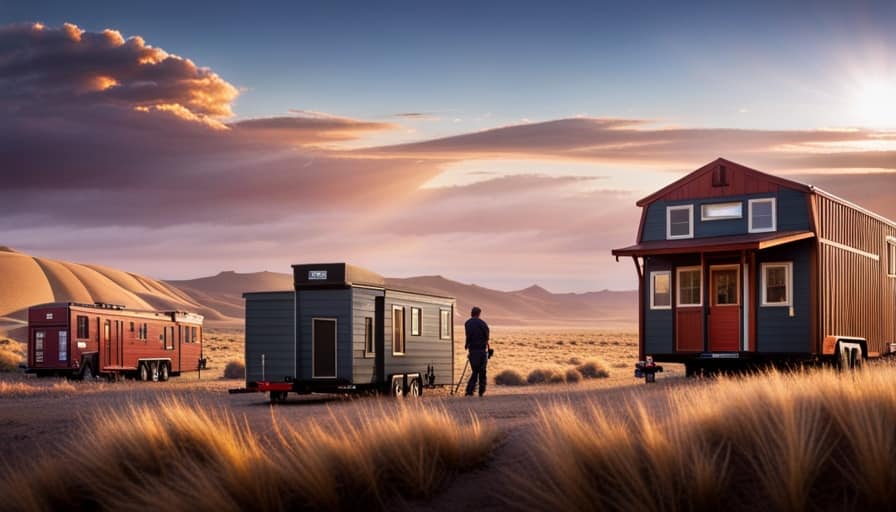We have you covered when it comes to financing your tiny house.
In this article, we’ll dive into the key factors you need to consider. From estimating costs to exploring funding options, we’ll provide you with the analytical and detailed information you need.
Whether you’re a first-time homeowner or a seasoned investor, our tips and guidance will help you navigate the world of tiny house financing.
Let’s get started on your path to financial success.

Key Takeaways
- Prioritize simplicity in design and explore alternative building materials to reduce construction costs.
- Consider energy-efficient solutions to reduce long-term expenses.
- Research hidden expenses such as permits, land acquisition, and utility connections.
- Evaluate different financing options, including lenders, loan programs, down payment requirements, and loan eligibility criteria.
Cost Estimation for Your Tiny House
We’ll need to take into account the various factors that go into estimating the cost of our tiny house. To ensure we’re well-prepared, we should consider implementing cost-saving strategies and carefully evaluate any potential hidden expenses. These strategies can significantly impact the overall affordability of our project.
One cost-saving strategy is to prioritize simplicity in our design, as complex designs can lead to higher construction costs. Additionally, we can explore alternative building materials and energy-efficient solutions to reduce long-term expenses.
It’s important to be diligent in our research and planning to identify any hidden expenses that may arise, such as permits, land acquisition, or utility connections. By considering these factors, we can develop a more accurate estimate of the cost of our tiny house and make informed decisions when budgeting for financing.
In order to effectively budget for financing, we must take into account various considerations.

Budgeting Considerations for Financing
To effectively budget for financing our tiny house, we must carefully consider the various financial factors and options available to us. It’s important to approach this process with a strategic mindset, taking into account cost saving strategies and thorough financial planning. Here are five key considerations to help us navigate this process:
-
Determine a realistic budget: Evaluate our current financial situation and set a budget that aligns with our income and expenses.
-
Research financing options: Explore different lenders and loan programs to find the best fit for our needs and financial goals.
-
Consider down payment requirements: Determine how much we can comfortably put towards a down payment and factor that into our budget.

-
Account for ongoing expenses: Plan for costs such as utilities, maintenance, and insurance to ensure we can comfortably afford our tiny house in the long run.
-
Explore cost-saving strategies: Look for ways to reduce expenses, such as opting for energy-efficient appliances or DIY projects.
Exploring Funding Options for Tiny Houses
When exploring funding options for tiny houses, it’s important to consider the loan eligibility criteria. Different lenders may have different requirements, such as credit score and income level, which can affect your ability to secure financing.
Additionally, it’s worth exploring alternative funding sources, such as grants or crowdfunding, which can provide additional financial support.

Lastly, understanding the repayment terms and options is crucial, as it will determine the affordability and feasibility of the loan in the long run.
Loan Eligibility Criteria
As we delve into exploring funding options for tiny houses, it’s important to understand the loan eligibility criteria. When considering financing for your tiny house, here are some key factors to keep in mind:
-
Loan eligibility requirements: Different lenders may have varying criteria for granting loans. It’s crucial to familiarize yourself with their specific requirements, such as income verification, employment history, and debt-to-income ratio.
-
Credit score assessment: Lenders typically assess your creditworthiness through your credit score. A higher credit score increases your chances of loan approval and may result in more favorable interest rates.

-
Down payment: Lenders often require a down payment as a percentage of the total loan amount. The size of the down payment can vary, and it’s important to consider this expense when planning your tiny house financing.
-
Debt-to-income ratio: Lenders evaluate your ability to repay the loan by assessing your debt-to-income ratio. This ratio compares your monthly debt payments to your monthly income and helps lenders determine your loan eligibility.
-
Collateral: Some lenders may require collateral to secure the loan. This could be your tiny house or other assets, providing lenders with a guarantee in case of default.
Understanding these loan eligibility criteria will help you navigate the financing process and make informed decisions when seeking funding for your tiny house.

Alternative Funding Sources
We can explore a few alternative funding sources for our tiny house, including personal savings, crowdfunding, and grants. Alternative financing methods can provide opportunities for individuals who may not qualify for traditional loans or who prefer not to take on debt. Personal savings is a common option, allowing individuals to use their own money to fund their tiny house project. Crowdfunding platforms like Kickstarter and Indiegogo offer another avenue for funding, where individuals can create campaigns and seek financial support from a larger community. Additionally, grants may be available from organizations or government agencies that support the development of sustainable and affordable housing. Exploring these alternative funding sources can help make our tiny house dreams a reality.
| Funding Source | Description | Pros | Cons |
|---|---|---|---|
| Personal Savings | Using personal savings to finance a tiny house project. | – No need to pay interest or debt |
- Complete control over the project | – May take time to save enough money
- May deplete personal savings |
| Crowdfunding | Creating a campaign on platforms like Kickstarter or Indiegogo to seek financial support from a larger community. | – Potential to raise significant funds - Can generate buzz and interest in the project | – Requires time and effort to create and promote a campaign
- No guarantee of reaching the funding goal |
| Grants | Applying for grants from organizations or government agencies that support affordable housing or sustainable development. | – Does not need to be repaid - Can provide substantial funding | – May require meeting specific eligibility criteria
- Competition for grants can be high |
Repayment Terms and Options
Exploring different repayment terms and options can help us navigate the various funding options available for our tiny house. When considering financing for our tiny house, it’s important to compare repayment terms offered by different lenders. This comparison can help us find the most favorable terms that suit our financial situation and goals.
Additionally, it’s worth exploring loan refinancing options to potentially lower our interest rates or monthly payments. Here are some key factors to consider when comparing repayment terms and exploring loan refinancing options:
- Interest rates: Compare the interest rates offered by different lenders to ensure we secure the most competitive rate.
- Loan duration: Assess the length of the loan and determine if it aligns with our financial goals and ability to make monthly payments.
- Early repayment penalties: Understand if there are any penalties for paying off the loan early and factor this into our decision-making process.
- Flexibility: Look for lenders that offer flexibility in terms of repayment options, such as the ability to make additional payments or adjust payment schedules.
- Loan refinancing options: Research the availability of loan refinancing options, which can help us secure better terms or lower interest rates in the future.
Considering these factors will allow us to make an informed decision when choosing the best repayment terms for our tiny house financing.

As we delve into the complexities of funding, it’s crucial to also consider the insurance considerations for our tiny house.
Insurance Considerations for Your Tiny House
When it comes to insuring your tiny house, there are several coverage options to consider. From liability insurance to property coverage, it’s important to evaluate your needs and select a policy that provides adequate protection.
Additionally, if your tiny house is on wheels and can be moved, you may need to explore insurance options that cater specifically to movable tiny homes.
Coverage Options for Tiny Houses
As we delve into the topic of coverage options for tiny houses, it’s important to consider the various insurance considerations for your tiny house. Protecting your investment is crucial, and having the right insurance coverage can give you peace of mind.

Here are some key factors to consider when it comes to insuring your tiny house:
-
Research insurance providers: Look for companies that specialize in insuring tiny houses, as they’ll have a better understanding of the unique requirements and potential risks associated with them.
-
Understand insurance requirements: Different states may have specific insurance requirements for tiny houses, so make sure you’re aware of any regulations you need to comply with.
-
Evaluate your coverage needs: Determine the level of coverage you need based on the value of your tiny house and the contents inside. This may include coverage for theft, damage, liability, and more.

-
Shop around for quotes: Get quotes from multiple insurance providers to ensure you’re getting the best coverage at a competitive price.
-
Consider cost-saving strategies: Some insurance providers offer discounts for safety features such as security systems, fire alarms, and storm-resistant construction.
By considering these insurance considerations, you can make an informed decision about the coverage options that are best for your tiny house.
Now, let’s explore the next section about insuring movable tiny homes.

Insuring Movable Tiny Homes
Let’s dive into the important aspect of protecting our investment by exploring the insurance considerations for our movable tiny homes.
Insuring portable tiny homes is crucial to safeguarding our property against potential risks and damages. When it comes to movable tiny house insurance, there are a few key factors to consider.
First, it’s important to find an insurance provider that specializes in insuring tiny houses, as they’ll understand the unique needs and challenges associated with these types of homes.
Additionally, it’s important to assess the value of our tiny house accurately to ensure that we’ve the appropriate coverage in case of any unforeseen events.

By understanding the ins and outs of movable tiny house insurance, we can ensure that our investment is protected and secure.
Now, let’s move on to understanding value appreciation in tiny houses.
Understanding Value Appreciation in Tiny Houses
One important aspect to consider when financing our tiny house is understanding the value appreciation it can experience. Tiny houses have gained popularity in recent years, and as a result, their value has been steadily increasing.
Here are five key factors to understand about value appreciation in tiny houses:

-
Location: The location of your tiny house plays a significant role in its value appreciation. Areas with high demand and limited supply will generally experience higher appreciation rates.
-
Quality of construction: Well-built tiny houses using high-quality materials tend to appreciate more than those with lower construction standards.
-
Upgrades and renovations: Adding upgrades and making renovations to your tiny house can increase its value, making it a more attractive investment.
-
Market trends: Understanding the current market trends in the tiny house industry can help you determine the potential for value appreciation.

-
Maintenance and upkeep: Proper maintenance and regular upkeep of your tiny house will help preserve its value and ensure potential appreciation.
Loan Options for Financing Your Tiny House
When it comes to financing your tiny house, it’s important to consider the different loan options available.
One key factor to consider is the interest rates offered by different lenders. Comparing interest rates can help you find the most affordable financing option for your tiny house.
Additionally, you should also explore the repayment options available to ensure that they align with your financial situation and goals.

Interest Rates Comparison
We should carefully compare interest rates when considering loan options for financing our tiny house. Interest rates play a significant role in determining the overall cost of our loan and can greatly impact our monthly payments. To make an informed decision, it’s essential to analyze the current interest rate trends and consider various factors such as our credit score, loan terms, and lender reputation.
Here are five key items to consider when comparing interest rates:
- Evaluate fixed-rate and adjustable-rate loan options.
- Research the average interest rates offered by different lenders.
- Consider the potential savings from refinancing options.
- Take into account any additional fees or charges associated with the loan.
- Explore potential discounts or incentives offered by lenders.
Repayment Options Available
To ensure we have flexibility and affordability, it is important to explore different repayment options available when financing our tiny house. When considering repayment terms, it is crucial to analyze the length of the loan and the monthly payment amount. Longer repayment terms may result in smaller monthly payments, but it could also mean paying more in interest over time. On the other hand, shorter repayment terms may involve higher monthly payments, but it allows us to pay off the loan faster and save on interest.
To make an informed decision, we should compare different interest rates offered by various lenders. It is advisable to obtain quotes from multiple sources and carefully review the terms and conditions. By doing so, we can identify the most favorable interest rate and select a repayment option that aligns with our financial goals.

To illustrate the importance of considering repayment options, here is a table that compares two hypothetical loan options:
| Loan Option | Repayment Term | Interest Rate |
|---|---|---|
| Option 1 | 10 years | 4.5% |
| Option 2 | 15 years | 3.9% |
As we can see from the table, Option 2 offers a longer repayment term with a lower interest rate. This means that although the monthly payment may be slightly higher, the overall cost of the loan over time will be lower compared to Option 1. It is crucial to carefully analyze the repayment options and select the one that best suits our financial situation and long-term goals.
Evaluating the Investment Potential of Tiny Houses
Our research shows that a tiny house’s investment potential can be influenced by various factors. When evaluating the market for tiny houses, it’s important to consider the location and demand. High-demand areas with limited housing options can offer greater potential returns.
Additionally, the quality and construction of the tiny house play a significant role in its investment potential. A well-built tiny house with high-quality materials is likely to retain its value and attract potential buyers or renters.

The design and functionality of the tiny house also contribute to its investment potential. Unique features and efficient use of space can make a tiny house more desirable and increase its value.
Finally, the overall market conditions and economic stability should be considered when evaluating the investment potential of a tiny house.
Transition: Now that we’ve discussed the evaluation of investment potential, let’s move on to addressing some common questions about financing a tiny house.
Common Questions About Financing a Tiny House
Now let’s address some common questions about financing a tiny house.

One of the first questions that often comes up is about the cost breakdown of a tiny house. When considering financing options, it’s important to have a clear understanding of the different expenses involved. These can include the cost of the land, the construction materials, labor, and any additional features or customization you might want. By breaking down these costs, you can get a better idea of how much financing you’ll need.
Another common question is about the pre-approval process for financing a tiny house. Just like with traditional mortgages, it’s a good idea to get pre-approved for a loan before starting the process. This involves submitting your financial information to a lender who’ll evaluate your creditworthiness and determine how much you can borrow. Pre-approval can give you a better idea of your budget and make the financing process smoother and more efficient.
It’s important to shop around and compare different lenders to find the best terms and interest rates for your tiny house financing.
Finding the Right Financing Plan for Your Tiny House
We have several options available when it comes to finding the right financing plan for our tiny house, but it’s important to carefully consider each one to ensure it aligns with our specific needs and goals.

Here are some key factors to consider when choosing a financing plan for our tiny house:
- Research different lenders and compare interest rates and terms.
- Consider the down payment requirements and whether they fit within our budget.
- Evaluate the repayment schedule and monthly payments to ensure they’re manageable.
- Take into account any additional fees or costs associated with the financing plan.
- Consider any legal considerations, such as zoning laws or building codes, that may impact the financing options available to us.
Tips for Negotiating Financing Terms for Your Tiny House
When negotiating financing terms for our tiny house, it is important to be prepared and assertive in order to secure the best possible terms. To effectively negotiate, we should research and understand the current market rates and loan options available. This will give us a better understanding of what terms are reasonable and what we can expect from lenders. It is also important to have a clear understanding of our financial situation and be able to articulate our needs and preferences. By being well-prepared, we can confidently negotiate for lower interest rates, longer repayment periods, or other favorable terms. Additionally, it is helpful to compare offers from different lenders and leverage any competing offers to our advantage. By following these tips, we can negotiate financing terms that align with our financial goals and make our tiny house dream a reality.
| Negotiating Tips | Loan Options |
|---|---|
| Research current market rates | Fixed-rate loans |
| Understand loan options available | Adjustable-rate loans |
| Know your financial situation | FHA loans |
| Compare offers from different lenders | Personal loans |
Table 1: Negotiating Financing Terms for Your Tiny House
Long-Term Financial Planning for Your Tiny House Investment
As owners of a tiny house, our long-term financial planning must include careful consideration of our investment’s maintenance costs, potential resale value, and overall sustainability. To ensure long term financial stability and maximize returns on our investment, it’s important to factor in future market trends and make informed decisions.

Here are five key aspects to consider when planning for the long-term financial success of our tiny house investment:
-
Maintenance costs: Regular upkeep and repairs are essential for maintaining the value of our tiny house. Budgeting for routine maintenance and unexpected repairs is crucial for long-term financial stability.
-
Resale value: Anticipating potential resale value is important when making initial investment decisions. Understanding market trends and demand for tiny houses can help us make informed decisions that maximize our returns.
-
Sustainability: Emphasizing sustainable features in our tiny house can increase its appeal and value in the future. Incorporating energy-efficient systems and eco-friendly materials not only benefits the environment but also enhances its marketability.

-
Future market trends: Staying informed about market trends in the tiny house industry can help us make strategic decisions. Monitoring changes in regulations, zoning laws, and consumer preferences can guide our long-term financial planning.
-
Insurance coverage: Adequate insurance coverage is essential to protect our investment. Ensuring that our tiny house is properly insured against damages, theft, and liability can provide peace of mind and protect our long-term financial stability.
Frequently Asked Questions
What Are the Best Ways to Secure Funding for a Tiny House?
When considering financing for a tiny house, it’s important to explore alternative options such as crowdfunding campaigns. These avenues can provide the necessary funds and support for your project, making your tiny house dreams a reality.
How Much Does Insurance Typically Cost for a Tiny House?
When it comes to insurance coverage for a tiny house, it’s important to consider factors such as the size and value of the house, location, and any additional features. Researching different insurance providers can help find the best coverage options.

Are There Any Tax Benefits or Incentives for Financing a Tiny House?
When financing a tiny house, it’s important to consider the potential tax benefits and government incentives available. These can help offset the costs and make the investment more financially viable in the long run.
Can I Use a Personal Loan to Finance My Tiny House?
Yes, we can use a personal loan as one of the financing options for our tiny house. However, it is important to consider various factors such as interest rates, repayment terms, and our financial capability before choosing this option.
What Are the Potential Risks and Challenges of Financing a Tiny House?
When financing a tiny house, there are potential risks and challenges to consider. It’s important to assess the potential risks involved and be prepared for any challenges that may arise during the financing process.
Conclusion
In conclusion, financing a tiny house requires careful consideration of various factors such as cost estimation, budgeting, funding options, insurance considerations, and long-term financial planning.

It’s interesting to note that according to a survey conducted by the American Tiny House Association, 68% of tiny house owners have reported a decrease in overall housing expenses after transitioning to a tiny house.
This statistic highlights the potential financial benefits and value appreciation that can be achieved through proper financing and investment in a tiny house.
I’m Theodore, and I love tiny houses. In fact, I’m the author of Tiny House 43, a book about tiny houses that are also tree houses. I think they’re magical places where imaginations can run wild and adventures are just waiting to happen.
While tree houses are often associated with childhood, they can be the perfect adult retreat. They offer a cozy space to relax and unwind, surrounded by nature. And since they’re typically built on stilts or raised platforms, they offer stunning views that traditional homes simply can’t match.
If you’re looking for a unique and romantic getaway, a tree house tiny house might just be the perfect option.










